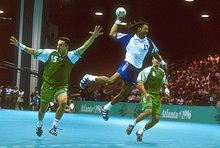The Injury
Sprain and strain are two different thing but people usually confuses it as the same. A sprain is an injury to a ligament i.e. stretching or tearing of a ligament. One or more ligaments can be injured during a sprain. The severity of the injury will depend on the extent of injury to a single ligament (whether the tear is partial or complete) and the number of ligaments involved. A strain is an injury to either a muscle or tendon. Depending on the severity of the injury, a strain may be a simple overstretch of the muscle or tendon, or it can result in a partial or complete tear. Ligaments provide connection between bones where as tendon connects the muscles to the bones.
Sprain occurs in any parts of the body but the most common location is the ankle. A sprain can result from a fall, a sudden twist, or a blow to the body that forces a joint out of its normal position. This results in an overstretch or tear of the ligament supporting that joint. Typically, sprains occur when people fall and land on an outstretched arm, slide into base, land on the side of their foot, or twist a knee with the foot planted firmly on the ground.
Most ankle sprains happen when the foot turns inward as a person runs, turns, falls, or lands on the ankle after a jump. This type of sprain is called an inversion injury. One or more of the lateral ligaments are injured, usually the anterior talofibular ligament. The calcaneofibular ligament is the second most frequently torn ligament.
Sprain occurs in any parts of the body but the most common location is the ankle. A sprain can result from a fall, a sudden twist, or a blow to the body that forces a joint out of its normal position. This results in an overstretch or tear of the ligament supporting that joint. Typically, sprains occur when people fall and land on an outstretched arm, slide into base, land on the side of their foot, or twist a knee with the foot planted firmly on the ground.
Most ankle sprains happen when the foot turns inward as a person runs, turns, falls, or lands on the ankle after a jump. This type of sprain is called an inversion injury. One or more of the lateral ligaments are injured, usually the anterior talofibular ligament. The calcaneofibular ligament is the second most frequently torn ligament.
When an ankle is injured with a sprain, tendon injury, or fracture, inflammation occurs. Blood vessels become 'leaky' and allow fluid to ooze into the soft tissue surrounding the joint. White blood cells responsible for inflammation migrate to the area, and blood flow increases as well causing it to bruise. Swelling occurs because of increased fluid in the tissue. Sometimes the swelling is so severe that you can leave an indentation in the swollen area by pressing on it with your finger. The sprain comes with pain because the nerves are more sensitive. The joint hurts and may throb. You can make the pain worse by pressing on the sore area, by moving the foot in certain directions (depending upon which ligament is involved) and by walking or standing.
Ankle sprain usually does not require a visit to the doctor, however, it is difficult to differentiate sprain from a more serious injury such as fracture of the talus bone in the ankle joint. The doctor might also want to check the Achilles tendon for rupture due to the injury. X-ray are sometimes necessary to make sure that there is no fracture.
Treatment
Treatment for sprain or strain comes in two stages. The goal during the first stage is to reduce swelling and pain. At this stage, doctors usually advise patients to follow a formula of rest, ice, compression, and elevation (RICE) for the first 24 to 48 hours after the injury. The doctor may also recommend an over-the-counter or prescription nonsteroidal anti-inflammatory drug, such as aspirin or ibuprofen, to help decrease pain and inflammation. For moderate sprains, a walking cast or a removable cast boot can be applied and left in place for up to 3 weeks. It immobilizes the lower leg but allows a person to walk on the injured ankle.
Prevention
There are many things people can do to help lower their risk of sprains and strains:
- Maintain a healthy, well-balanced diet to keep muscles strong.
- Maintain a healthy weight.
- Practice safety measures to help prevent falls (for example, keep stairways, walkways, yards, and driveways free of clutter, and salt or sand icy patches in the winter).
- Wear shoes that fit properly.
- Replace athletic shoes as soon as the tread wears out or the heel wears down on one side.
- Do stretching exercises daily.
- Be in proper physical condition to play a sport.
- Warm up and stretch before participating in any sports or exercise.
- Wear protective equipment when playing.
- Avoid exercising or playing sports when tired or in pain.
- Run on even surfaces.








No comments:
Post a Comment